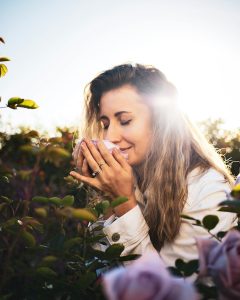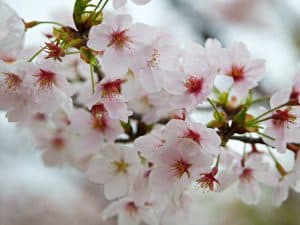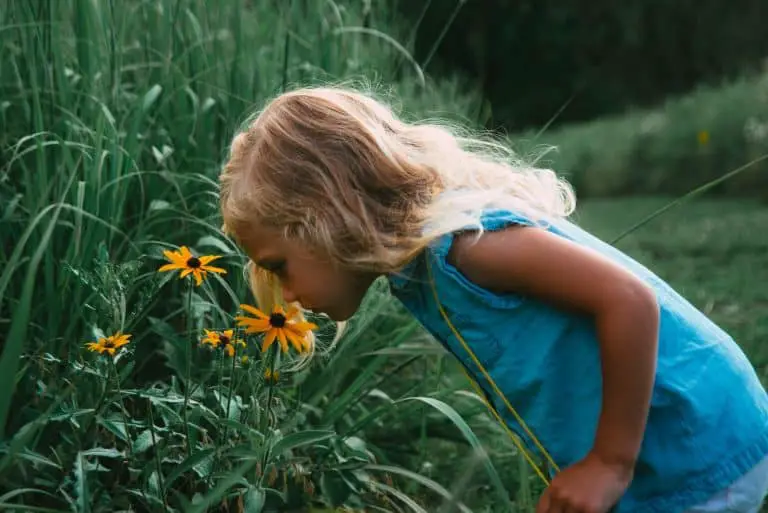Crafting an outdoor space that’s unique, charming, and fragrant is an art in itself. It’s more than just a visual delight; it’s about creating a multisensory experience that engages and captivates. That’s where the magic of fragrant flowers comes into play. With 27 seed and bulb varieties at your disposal, you’ll have the opportunity to bring exotic fragrant flower garden to your backyard.
Every blooming season brings its own unique sweet smell, transforming your garden into an ever-changing aromatic paradise. But it’s not just about the scent. A fragrant garden is also a bustling hub for bees, butterflies, and even bats at night, making it a haven for wildlife.
So, ready to stop and smell the roses? Let’s dive into the world of fragrant gardens and explore the best flowering plants to make your garden a sensory delight.
Fragrant Flower Garden: A Symphony of Sweet Scents
In creating your fragrant flower garden, consider your personal ideal scents and moods. Fragrance is widely personal, and everyone’s scent preference differs. So use your nose! The scents that resonate with you will create the atmosphere you desire.
Think also of the locations where you plant. It’s a marvelous idea to plant hyacinths beside your front door. The intoxicating scent welcomes you home, and greets visitors with a fragrant hello. Position lilacs under your bedroom window for a natural and restful sleep aid. The sweet, heady aroma drifts through the window, enhancing your dreams. It is truly an olfactory joy to have Oriental lilies in planters on your patio.

The robust scent engulfs the outdoor space, turning your patio into a fragrant paradise. Edge your pathways with sweet alyssum or lavender for a calming scent journey as you meander through your haven. Surround your deck or patio with potted gardenias, jasmine, and crinum. The sweet smelling symphony serves as a beautiful and aromatic boundary.
Growing fragrant roses behind a garden bench is another aromatic delight. Perched on the bench, you experience not just the sight but the pleasing scent of the roses. Its perfume pervades the air around you, creating an undeniably relaxing setting. This is our garden bench: not only a place to rest, but also a place to indulge the senses.
As avid gardeners, we often get so focused on the visual beauty of plants. It’s aesthetically pleasing to see a vibrant splash of colors in our flower beds and containers. But consider the underappreciated feature of fragrance. Fragrance adds a new level of enjoyment to our gardens. A fragrant flower garden offers not just a feast for the eyes, but a feast for the senses as well. By incorporating fragrant plants, we create an experience that transcends the visual, engaging our sense of smell in the process.
What is the Most Fragrant Flower in the World?
When it comes to fragrant flowers, different scents appeal to everyone. We’re often asked, “What is the most fragrant flower in the world?” Well, it’s subjective! Some love a rich and heady scent, while others prefer a light and fresh one.
But, if you’re looking for a general consensus, roses often take top spot. Known worldwide not just for their beauty but also their delightful fragrance, roses are a top choice in many gardens. They bloom long and offer a variety of colours to spruce up your surroundings. The catch? They’re a bit picky about growing conditions and need Zones 3-11 to thrive, based on the Rosa variety.
If your sweet spot is strong fragrances, don’t overlook syringas or lilacs as they’re commonly called. These intriguing spring bloomers let off an extremely potent fragrance and are super easy to care for once established. A plus point? They make great cut flower bouquets, allowing you to bring their wonderful fragrance indoors. Their growing zone requirement? Zones 2-8.
For those residing in warmer climates, meet the gardenia. This year-round spring blooming shrubs produces tiny white flowers that are remarkably fragrant. Ideal for zones 7-11, it offers not just an enchanting smell but also an aesthetic appeal, especially given its evergreen nature. A great option if you’re looking to create a natural evergreen hedge sprinkled with sweet-smelling flowers.
| Flower | Fragrance Level | Growth Zones | Scientific Name |
| Roses | Mild to strong (depending on variety) | 3-11 | Rosa |
| Lilacs (Syringa) | Extremely Strong | 2-8 | Syringa |
| Gardenia | Strong | 7-11 | Gardenia |
The Fragrance of Spring
Spring ushers in a bounty of olfactory delights with its bloom. Becoming familiar with your local plant palette is a great starting point. By understanding which plants will yield the desired fragrances throughout the year, you can develop a personalized fragrance calendar.
Take the early spring, for example. Fragrance can make an entry right at the onset of the thaw. Plant snowdrops, crocuses, scilla, and grape hyacinths. They all emanate that much-anticipated sweet scent that marks the end of winter.
The power of scent doesn’t stop with summer’s arrival. Lavender, rosemary, salvia, and thyme infuse the air with pleasant fragrances. These hardworking perennials are perfect choices for your summer garden.
If fall is the season that leaves you craving aromas, add some spice to your life with chrysanthemums and dianthus. Their rich, spicy scent mingles with the crisp autumn air to create a unique sensory experience.

Peonies are another aromatic addition to consider. Their smell varies from light, citrusy to sweet and spicy. Early, midseason, or late blooming, peonies are known for their extended bloom time, filling your garden with their scent from midspring right through to early summer.
Factor in plants like evergreens, holly, and sweet box for winter. Even this stark season can be transformed into a fragrant wonderland with the right plant selection.
Remember, your garden is not just a visual delight. By maximizing the use of fragrant plants from every season, you’ll have a garden that’s always full of scent.
The Fragrance of Summer
During summer, when the days are warm and nights offer a cool respite, the intoxicating scent Nicotiana alata often wafts across the flower gardens. Known also as flowering tobacco or jasmine tobacco, this plant blooms star-shaped flowers that enhance your garden’s aroma from summer all the way into fall.
Moon gardens are an excellent place for this plant, as its strong and sweet fragrance is most pronounced at night. Nicotiana comes in a variety of colors including white, cream, yellow, lime green, pink, and red. Its hardy nature allows it to grow as a perennial in frost-free regions, although it’s typically seen as an annual.
Growing Conditions: Full sun to part shade, moist, well-drained soil
Size Up to 5 feet tall
Zones: 10-11
As summer progresses, you might detect a light, citrusy aroma followed by a sweet and spicy scent. That would be thanks to peonies. Doubly delightful, early, midseason, or late-blooming peonies create waves of fragrance from midspring through early summer.
Indeed, flowers have a knack of bearing the personality of their colors. Nothing embodies this more than the fruity scent of freesia. Its delicate jewel-toned flowers are reminiscent of fresh strawberries, adding a lively painting of scents to summer gardens. Interestingly, freesia is easy to grow, and the creamy white blooms of Freesia alba rank as the most fragrant variety.
Last but not least, if you have a sweet tooth, you’ll love the unique scent of chocolate cosmos (Cosmos atrosanguineus). While the plant doesn’t make for a good dessert, there’s no denying its distinctive smell reflecting its name. The summer heat brings out its signature aroma, which holds a striking semblance to chocolate.
In the grand scheme of crafting a fragrant flower, the garden offers an opportunity to evoke refreshing summertime nostalgia potent with stirring floral scents. Hence, the focus on choosing summer plants is more than just about their aesthetic appeal; it’s a surefire way to enliven your olfactory senses.
The Fragrance of Autumn
As we move from summer’s vibrant scent mix, the spotlight swivels. It’s the time for Autumn flowers to seize the stage. I’ve found Autumn to be a unique season that fills up the fragrance gaps of late winter and late autumn quite beautifully. We are talking about an underutilized shrub in most gardens: the witch hazel.
Its two types, Hamamelis vernalis and Hamamelis virginiana, are impressive in their own ways. The Spring-blooming witch hazel (Hamamelis vernalis) is a revelation to the nose during late winters. Its intensely fragrant flowers are among the earliest to bloom in gardens.
On the other hand, our North American native witch hazel (Hamamelis virginiana) is a breath of fresh air in Autumn. It coincides its flowering with leaf changing. The golden yellow of the leaves coupled with the sweet, intoxicating fragrance gives a fine fall day its character.
Switching to a different aroma palette, roses assert their presence in the garden too. Rose is one bloom that halts you: their spicy, fruity, musky, varied perfumes run a gamut. For maximum impact from your garden placing them strategically next to paths or benches adds a je ne sais quoi to a regular garden stroll. Varieties to try out could be an old-fashioned one like Louise Odier (originating from France, 1851) or a modern-climber like Gertrude Jekyll.
Finally, we move to the unsung heroes of a fragrant garden: Hostas. Mostly praised for their attractive leaves, a handful of them also house sweetly fragrant flowers. Some top contenders from the lot include varieties like Guacamole, Stained Glass, and So Sweet. Its glossy dark green leaves edged in cream bless you with a scent singularity.
Designing with scent can add a new dimension to one’s sensory encounters with their garden. Aircrafting the perfect olfactory experience links us directly with nature’s cycle. Autumn then plays its part by delivering its own captivating fragrances. And it’s these olfactory signatures that end up being the show-stealers. They not only satisfy the humans lingering around but also draw crucial pollinators. After all, who wouldn’t be swayed by the enchantment of Autumn scents?
The Fragrance of Winter
As the chill of winter approaches, your scented garden doesn’t have to go into hibernation. Surprisingly, many plants thrive during the colder months and can serve to bridge the fragrance gap between the warmth of the fall colors and the first breath of spring.
The standout in many winter gardens is the witch hazel shrub. Despite being somewhat underused, witch hazel can deliver an enchanting fragrance in your garden during the chillier parts of the year. Our North American native witch hazel, Hamamelis virginiana, is particularly popular during autumn when it flowers as its leaves turn a radiant golden yellow. The scent of witch hazel is something of a treat – equal parts sweet and intoxicating.
It’s not just your nose witch hazel benefits. The spring-blooming witch hazel is among the first to bloom in your garden. This not only offers a hint of an early spring, but it can also bring some much-needed color to a wintery landscape.
To ensure that witch hazel isn’t the only plant adding to your winter fragrance collection, there’s an assortment of other cold-hardy plants waiting for their moment in the garden. Winter jasmine (Jasminum nudiflorum) is one option that can’t be overlooked. More than just a pretty sight, jasmine’s distinctive scent is often described as rich and sweet with an enticing hint of musk.
It’s worth noting that the selection of winter-blooming fragrant plants extends beyond witch hazel and winter jasmine. Plants like evergreens, holly, and sweet box are just a few that you might want to consider. After all, incorporating a variety of fragrant plants will keep your garden smelling as good as it looks throughout the year!
By strategically planting and understanding your local plant palette, you’ll develop a veritable fragrance calendar where each area of your garden benefits. Your nose will thank you, as will the many pollinators that rely on winter blooms for survival.
Design Tips for Your Fragrance Garden
So there you have it. I’ve shared the beauty of a fragrant flower garden and how it can enhance your outdoor experience. Remember, it’s not just about the visual appeal. It’s about engaging your senses, particularly your sense of smell. From roses to lilacs, gardenias to hostas, every plant adds a unique scent that can elevate your mood and create a desired atmosphere.
Don’t forget about the autumn and winter plants like witch hazel and winter jasmine, which can keep your garden smelling heavenly all year round. It’s about strategic placement, personal preference, and a love for nature. With these tips, you’ll be well on your way to creating your own fragrant paradise. So go ahead, start planning your fragrance garden today. After all, who wouldn’t want a garden that looks as good as it smells?
Frequently Asked Questions
1. What factors should be considered when creating a fragrant flower garden?
When creating a fragrant flower garden, one should consider personal scent preferences and different moods. The placement of the plants is also crucial for creating the desired atmosphere and enhancing experiences.
2. What benefits does fragrance bring to a garden?
Fragrance adds a new level of enjoyment to a garden. It enhances the sensory experience by engaging the sense of smell, and can also attract pollinators, thereby promoting biodiversity.
3. Which are some of the most fragrant flowers I can plant?
Some of the most fragrant flowers include roses, lilacs, and gardenias. Choosing plants with these fragrant flowers can add a lovely scent to your garden.
4. What kind of flowers can bring fragrance to my garden in autumn?
To bring fragrance to your garden in autumn, consider planting the witch hazel shrub. Blooming in late winter and autumn, witch hazel releases an intense fragrance.
5. Are there any fragrant flowers I should try in my garden, which may not be so well-known?
Yes, hostas, though not as well-known, are a great addition to a fragrant garden. They have sweetly fragrant flowers and are often referred to as the ‘unsung heroes’ of a fragrant garden.
6. Which fragrant plants thrive during the winter months?
Witch hazel and winter jasmine both thrive during the colder winter months and release lovely fragrances. Having these plants in your garden ensures an enjoyable scent year-round.


